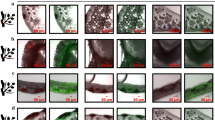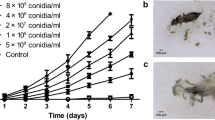Abstract
Fusarium graminearum causes Fusarium head blight (FHB) in wheat, resulting in severe yield losses. Further, it produces mycotoxins, which can have adverse effects on human health. This study aimed to assess the biocontrol efficacy of Metarhizium anisopliae against F. graminearum causing FHB in wheat. M. anisopliae significantly inhibited F. graminearum mycelial growth in the dual culture test, resulting in hyphal deformation at the site of its hyphal tips. Similar effects were observed with a 1% concentration of broth filtrates from M. anisopliae on mycelial growth and hyphal morphology of F. graminearum. However, the same was not observed for its volatiles. Furthermore, a 1% concentration of broth filtrates impeded conidial germination of F. graminearum. The colonisation ability of M. anisopliae on wheat roots was validated through eGFP-labelled M. anisopliae strain Ma-eGFP. The positive effects of M. anisopliae on seedling growth and single-spike weight of wheat were recorded. However, no noticeable effect on the 1000-seed weight of wheat was observed. Results from field experiments revealed that treating wheat seeds with the seed coating agent of M. anisopliae and spraying wheat heads with M. anisopliae conidia suspension resulted in a significant control efficacy of 38.6% and 40.1% at the early flowering period of wheat, respectively. These findings suggest that M. anisopliae is a promising biocontrol agent against F. graminearum causing FHB in wheat, and may fight against FHB by producing fungistatic secondary metabolites, enhancing wheat growth, and eliciting wheat defence responses.







Similar content being viewed by others
Availability of data and material
All data generated or analysed during this study are included in this published article.
References
Alexander NJ, McCormick SP, Waalwijk C, van der Lee T, Proctor RH (2011) The genetic basis for 3-ADON and 15-ADON trichothecene chemotypes in Fusarium. Fungal Genet Biol 48(5):485–495. https://doi.org/10.1016/j.fgb.2011.01.003
Beukes I, Rose LJ, van Coller GJ, Viljoen A (2018) Disease development and mycotoxin production by the Fusarium graminearum species complex associated with South African maize and wheat. Eur J Plant Pathol 150:893–910. https://doi.org/10.1007/s10658-017-1331-5
Beyer M, Roding S, Ludewig A, Verreet JA (2004) Germination and survival of Fusarium graminearum macroconidia as affected by environmental factors. J Phytopathol 152(2):92–97. https://doi.org/10.1111/j.1439-0434.2003.00807.x
Blandino M, Haidukowski M, Pascale M, Plizzari L, Scudellari D, Reyneri A (2012) Integrated strategies for the control of Fusarium head blight and deoxynivalenol contamination in winter wheat. Field Crops Res 133:139–149. https://doi.org/10.1016/j.fcr.2012.04.004
Boutigny AL, Beukes I, Viljoen A (2011) Head blight of Barley in South Africa is caused by Fusarium graminearum with a 15-adon chemotype. J Plant Pathol 93(2):321–329. https://doi.org/10.4454/jpp.v93i2.1186
Canassa F, D’Alessandro CP, Sousa SB, Demétrio CG, Meyling NV, Klingen I Jr, TD, (2020) Fungal isolate and crop cultivar influence the beneficial effects of root inoculation with entomopathogenic fungi in strawberry. Pest Manag Sci 76(4):1472–1482. https://doi.org/10.1002/ps.5662
Chen Y, Wang J, Yang N, Wen Z, Sun X, Chai Y, Ma Z (2018) Wheat microbiome bacteria can reduce virulence of a plant pathogenic fungus by altering histone acetylation. Nat Commun 9(1):3429. https://doi.org/10.1038/s41467-018-05683-7
Colombo EM, Kunova A, Pizzatti C, Saracchi M, Cortesi P, Pasquali M (2019) Selection of an endophytic Streptomyces sp. strain DEF09 from wheat roots as a biocontrol agent against Fusarium graminearum. Front Microbiol 10:2356. https://doi.org/10.3389/fmicb.2019.02356
Etebarian HR, Sholberg PL, Eastwell KC, Sayler RJ (2005) Biological control of apple blue mold with Pseudomonas fluorescens. Can J Microbiol 51(7):591–598. https://doi.org/10.1139/w05-039
Gonzalez-Hernandez GA, Padilla-Guerrero IE, Martinez-Vazquez A, Torres-Guzman JC (2020) Virulence factors of the entomopathogenic genus Metarhizium. Curr Protein Pept Sci 21(3):324–330. https://doi.org/10.2174/1389203721666200116092407
Guerrero-Guerra C, Reyes-Montes MD, Toriello C, Velázquez VMH (2013) Study of the persistence and viability of Metarhizium acridum in Mexico’s agricultural area. Aerobiologia 29:249–261. https://doi.org/10.1007/s10453-012-9277-8
Huang R, Li GQ, Zhang J, Yang L, Che HJ, Jiang DH, Huang HC (2011) Control of postharvest botrytis fruit rot of strawberry by volatile organic compounds of Candida intermedia. Phytopathology 101(7):859–869. https://doi.org/10.1094/PHYTO-09-10-0255
Jaber LR, Enkerli J (2016) Effect of seed treatment duration on growth and colonization of Vicia faba by endophytic Beauveria bassiana and Metarhizium brunneum. Biol Control 103:187–195. https://doi.org/10.1016/j.biocontrol.2016.09.008
Kemp ND, Vaughan MM, McCormick SP, Brown JA, Bakker MG (2020) Sarocladium zeae is a systemic endophyte of wheat and an effective biocontrol agent against Fusarium head blight. Biol Control 149:104329. https://doi.org/10.1016/j.biocontrol.2020.104329
Keyser CA, Jensen B, Meyling NV (2016) Dual effects of Metarhizium spp. and Clonostachys rosea against an insect and a seed-borne pathogen in wheat. Pest Manag Sci 72(3):517–526. https://doi.org/10.1002/ps.4015
Khan AL, Hamayun M, Khan SA, Kang SM, Shinwari ZK, Kamran M, Rehman SU, Kim JG, Lee IJ (2012) Pure culture of Metarhizium anisopliae LHL07 reprograms soybean to higher growth and mitigates salt stress. World J Microbiol Biotechnol 28(4):1483–1494. https://doi.org/10.1007/s11274-011-0950-9
Khaskheli MA, Wu L, Chen G, Chen L, Hussain S, Song D, Liu S, Feng G (2020) Isolation and characterization of root-associated bacterial endophytes and their biocontrol potential against major fungal phytopathogens of rice (Oryza sativa L.). Pathogens 9(3):172. https://doi.org/10.3390/pathogens9030172
Kim YT, Monkhung S, Lee YS, Kim KY (2019) Effects of Lysobacter antibioticus HS124, an effective biocontrol agent against Fusarium graminearum, on crown rot disease and growth promotion of wheat. Can J Microbiol 65(12):904–912. https://doi.org/10.1139/cjm-2019-0285
Krnjaja V, Mandić V, Lević J, Stanković S, Petrović T, Vasić T, Obradović A (2015) Influence of N-fertilization on Fusarium head blight and mycotoxin levels in winter wheat. Crop Prot 67:251–256. https://doi.org/10.1016/j.cropro.2014.11.001
Lachhab N, Sanzani SM, Fallanaj F, Youssef K, Nigro F, Boselli M, Ippolito A (2015) Protein hydrolysates as resistance inducers for controlling green mould of citrus fruit. Acta Hortic 1065:1593–1598. https://doi.org/10.17660/ActaHortic.2015.1065.203
Legrand F, Picot A, Cobo-Diaz JF, Chen W, Le Floch G (2017) Challenges facing the biological control strategies for the management of Fusarium Head Blight of cereals caused by F. graminearum. Biol Control 113:26–38. https://doi.org/10.1016/j.biocontrol.2017.06.011
Leplat J, Friberg H, Abid M, Steinberg C (2012) Survival of Fusarium graminearum, the causal agent of Fusarium head blight. A Review Agron Sustain Dev 33(1):97–111. https://doi.org/10.1007/s13593-012-0098-5
Liang LQ, Li JQ, Cheng L, Ling J (2014) A high efficiency gene disruption strategy using a positive-negative split selection marker and electroporation for Fusarium oxysporum. Microbiol Res 169(11):835–843. https://doi.org/10.1016/j.micres.2014.03.004
Liu SF, Wang GJ, Nong XQ, Bin L (2017) Entomopathogen Metarhizium anisopliae promotes the early development of peanut root. Plant Prot Sci 53(2):101–107. https://doi.org/10.17221/49/2016-PPS
Lopez CG, Castellanos LNM, Ortiz NAF, Gonzalez JAG (2019) Control of powdery mildew (Leveillula taurica) using Trichoderma asperellum and Metarhizium anisopliae in different pepper types. Biocontrol 64(1):77–89. https://doi.org/10.1007/s10526-018-09916-y
Palazzini J, Roncallo P, Cantoro R, Chiotta M, Yerkovich N, Palacios S, Echenique V, Torres A, Ramírez M, Karlovsky P, Chulze S (2018) Biocontrol of Fusarium graminearum sensu stricto, reduction of deoxynivalenol accumulation and phytohormone induction by two selected antagonists. Toxins 10(2):88. https://doi.org/10.3390/toxins10020088
Palazzini JM, Alberione E, Torres A, Donat C, Köhl J, Chulze S (2016) Biological control of Fusarium graminearum sensu stricto, causal agent of Fusarium head blight of wheat, using formulated antagonists under field conditions in Argentina. Biol Control 94:56–61. https://doi.org/10.1016/j.biocontrol.2015.12.009
Rahman SFSA, Singh E, Pieterse CMJ, Schenk PM (2018) Emerging microbial biocontrol strategies for plant pathogens. Plant Sci 267:102–111. https://doi.org/10.1016/j.plantsci.2017.11.012
Rath AC, Koen TB, Anderson GC, Worledge D (1995a) Field evaluation of the entomogenous fungus Metarhizium anisopliae (DAT F-001) as a biocontrol agent for the redheaded pasture cockchafer, Adoryphorus couloni (Coleoptera: Scarabaeidae). Aust J Agric Res 46(2):429–440. https://doi.org/10.1071/AR9950429
Rath AC, Worledge D, Koen TB, Rowe BA (1995b) Long-term field efficacy of the entomogenous fungus Metarhizium anisopliae against the subterranean scarab Adoryphorus couloni. Biocontrol Sci Technol 5(4):439–451. https://doi.org/10.1080/09583159550039639
Rivas-Franco F, Hampton JG, Morán-Diez ME, Narciso J, Rostás M, Wessman P, Jackson TA, Glare TR (2019) Effect of coating maize seed with entomopathogenic fungi on plant growth and resistance against Fusarium graminearum and Costelytra giveni. Biocontrol Sci Technol 29(9):877–900. https://doi.org/10.1080/09583157.2019.1611736
Roberto SR, Youssef K, Hashim AF, Ippolito A (2019) Nanomaterials as alternative control means against postharvest diseases in fruit crops. Nanomaterials-Basel 9(12):1752. https://doi.org/10.3390/nano9121752
Roberts DW, St Leger RJ (2004) Metarhizium spp., cosmopolitan insect-pathogenic fungi: mycological aspects. Adv Appl Microbiol 54:1–70. https://doi.org/10.1016/S0065-2164(04)54001-7
Rocha ID, Ma Y, Souza-Alonso P, Vosatka M, Freitas H, Oliveira RS (2019) Seed coating: a tool for delivering beneficial microbes to agricultural crops. Front Plant Sci 10:1357. https://doi.org/10.3389/fpls.2019.01357
Rojas EC, Jensen B, Jorgensen HJL, Latz MAC, Esteban P, Ding YW, Collinge DB (2020) Selection of fungal endophytes with biocontrol potential against Fusarium head blight in wheat. Biol Control 144:104222. https://doi.org/10.1016/j.biocontrol.2020.104222
Russo ML, Pelizza SA, Vianna MF, Allegrucci N, Cabello MN, Toledo AV, Mourelos C, Scorsetti AC (2019) Effect of endophytic entomopathogenic fungi on soybean Glycine max (L.) Merr. growth and yield. J King Saud Uni-Sci 31(4):728–736. https://doi.org/10.1016/j.jksus.2018.04.008
San Aw KM, Hue SM (2017) Mode of infection of Metarhizium spp. fungus and their potential as biological control agents. J Fungi 3(2):30. https://doi.org/10.3390/jof3020030
Sarven MS, Hao QY, Deng JB, Yang F, Wang GF, Xiao YN, Xiao XQ (2020) Biological control of tomato gray mold caused by Botrytis cinerea with the entomopathogenic fungus Metarhizium anisopliae. Pathogens 9(3):213. https://doi.org/10.3390/pathogens9030213
Shah L, Ali A, Yahya M, Zhu Y, Wang S, Si H, Rahman H, Ma C (2018) Integrated control of Fusarium head blight and deoxynivalenol mycotoxin in wheat. Plant Pathol 67:532–548. https://doi.org/10.1111/ppa.12785
Talbot NJ, Ebbole DJ, Hamer JE (1993) Identification and characterization of MPG1, a gene involved in pathogenicity from the rice blast fungus Magnaporthe grisea. Plant Cell 5(11):1575–1590. https://doi.org/10.1105/tpc.5.11.1575
Ueno T, Miyagawa H, Tsurushima T, Inoue M (1997) Spore germination self-inhibitors from plant pathogenic fungi. J Pestic Sci 22:342–350. https://doi.org/10.1584/jpestics.22.342
Valizadeh H, Abbasipour H, Mahmoudvand M, Askary H, Moniri VR (2011) Laboratory trials of Metarhizium anisopliae var. acridum (Green Muscle®) against the saxaul locust, Dericorys albidula Serville (Orthopera: Dericorythidae). Chil J Agr Res 71(4):549–553. https://doi.org/10.4067/s0718-58392011000400008
Wang Q, Vera Buxa S, Furch A, Friedt W, Gottwald S (2015) Insights into Triticum aestivum seedling root rot caused by Fusarium graminearum. Mol Plant Microbe in 28(12):1288–1303. https://doi.org/10.1094/MPMI-07-15-0144-R
Youssef K, Roberto SR, de Oliveira AG (2019) Ultra-structural alterations in Botrytis cinerea-the causal agent of gray mold-treated with salt solutions. Biomolecules 9(10):582. https://doi.org/10.3390/biom9100582
Zheng YK, Qiao XG, Miao CP, Liu K, Chen YW, Xu LH, Zhao LX (2015) Diversity, distribution and biotechnological potential of endophytic fungi. Ann Microbiol 66(22):529–542. https://doi.org/10.1007/s13213-015-1153-7
Acknowledgements
This work was supported by the National Key Research and Development Program of China (2018YFD0200500, 2017YFD0201604 and 2018YFD0201201). We are thankful to Prof. Qiuying Huang and Jiatao Xie of Huazhong Agricultural University for providing M. anisopliae and F. graminearum, respectively.
Funding
This work was supported by the National Key Research and Development Program of China (2018YFD0200500, 2017YFD0201604 and 2018YFD0201201, respectively).
Author information
Authors and Affiliations
Contributions
Formal analysis and investigation, Writing—original draft preparation [Qiuyan Hao]; Formal analysis and investigation [Dosouky Mohammad Dosouky Albaghdady]; Supervision, Writing—review and editing, Funding acquisition [Yannong Xiao]; Methodology [Xueqiong Xiao]; Formal analysis and investigation [Chenmi Mo]; Formal analysis and investigation [Tian Tian]; Supervision, Resources, Writing—review and editing, Conceptualization, Funding acquisition [Gaofeng Wang].
Corresponding author
Ethics declarations
Conflicts of interest
The authors declare that they do not have any actual or potential conflict of interest.
Additional information
Publisher's Note
Springer Nature remains neutral with regard to jurisdictional claims in published maps and institutional affiliations.
Rights and permissions
About this article
Cite this article
Hao, Q., Albaghdady, D.M.D., Xiao, Y. et al. Endophytic Metarhizium anisopliae is a potential biocontrol agent against wheat Fusarium head blight caused by Fusarium graminearum. J Plant Pathol 103, 875–885 (2021). https://doi.org/10.1007/s42161-021-00866-6
Received:
Accepted:
Published:
Issue Date:
DOI: https://doi.org/10.1007/s42161-021-00866-6




